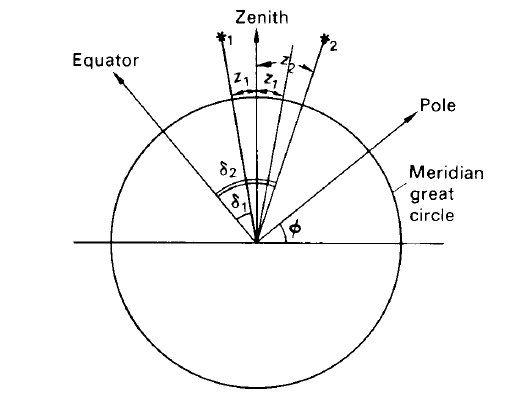
Zenith tubes
 المؤلف:
A. Roy, D. Clarke
المؤلف:
A. Roy, D. Clarke
 المصدر:
Astronomy - Principles and Practice 4th ed
المصدر:
Astronomy - Principles and Practice 4th ed
 الجزء والصفحة:
p 344
الجزء والصفحة:
p 344
 29-8-2020
29-8-2020
 2165
2165
Zenith tubes
Very accurate positions of the latitude of an observatory are obtained by using zenith tubes of which there are several designs. Their advantages over the transit telescope for this particular purpose are that the instrument does not suffer from flexure, as it is always used in a near vertical position, and the effects of atmospheric refraction are very small. Regular positional measurements by this type of instrument allow the motions of the Earth’s poles to be studied.
The zenith tube or telescope consists of a small refractor which is limited in movement so that only the zenith field can be observed. In its basic form, the measurements are made using a micrometer eyepiece but there are several more modern versions using photographic and electronic recording techniques which provide improved accuracy.
A single determination of an instrument’s position requires measurements of the difference in zenith distance of two stars when they are placed on the observer’s meridian—absolute zenith distances are not required. The telescope is first directed to a position which is just south of the zenith and the micrometer eyepiece adjusted so that the transit of a star is made to occur along the horizontal wire. By turning the telescope through 180◦ about a vertical axis, transits occurring just north of the zenith can be observed. When a suitable star appears in the field, the horizontal wire is adjusted by the micrometer

Figure 1. Measurements of two stars on the meridian using the zenith tube.
screw so that the transit is made along the same wire. The difference between the settings of the wire is read off the micrometer and this is then converted to angular measure.
Suppose that two stars have declinations δ1 and δ2 and appear on the meridian at a particular site when the zenith distances are z1 and z2 (see figure 1). The measurements made by the zenith tube provide a value for (z2 − z1). It is readily seen from figure 1 that the latitude, ∅, of the
observing station is given by
∅ = δ1 + z1. (1)
It can also be seen from the same figure that
δ2 = δ1 + z1 + z2 = δ1 + 2z1 + (z2 − z1).
Therefore,
 (2)
(2)
By substituting equation (2) into (1), we have

or
 (3)
(3)
Thus, the latitude of the observing station is the mean of the stars’ declinations, corrected for half the difference of their zenith distances.
Accurate positions of longitude may be determined if the transit times are also recorded.
 الاكثر قراءة في مواضيع عامة في علم الفلك
الاكثر قراءة في مواضيع عامة في علم الفلك
 اخر الاخبار
اخر الاخبار
اخبار العتبة العباسية المقدسة


